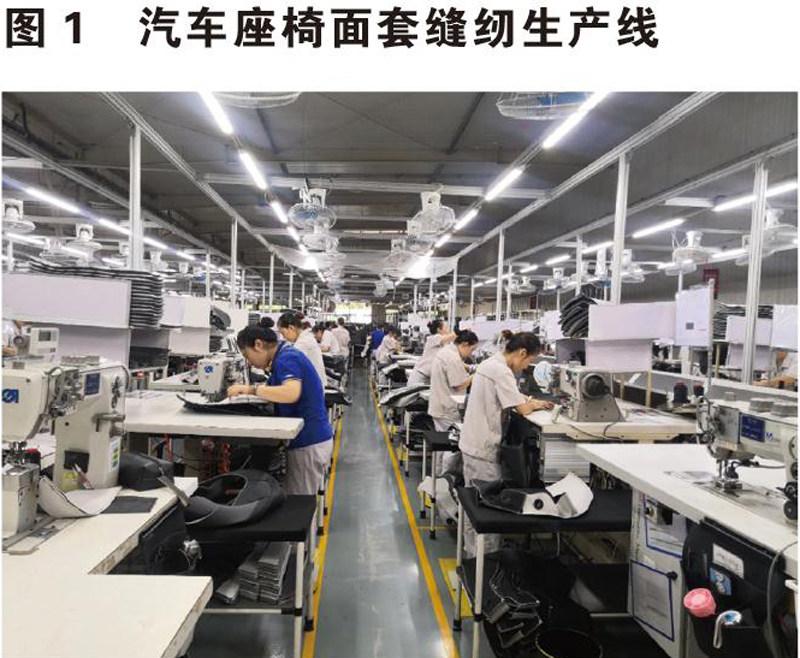汽车座椅面套生产效率提升方法的探讨
2021-10-13高楠楠孙润生杨璐
高楠楠 孙润生 杨璐



摘 要:全球汽车行业自动化水平不断上升,而汽车座椅面套生产仍然属于人工劳动密集型产业。虽然某些特种工序也采用自动化缝纫设备进行加工,但是95%以上的工序必须采用人工完成转弯、翻转、开缝、卷边等多种复杂的缝纫工艺,才能将二维裁片缝合成立体结构,所以提升生产效率关键还是要从研究操作者作业着手。汽车座椅面套生产与服装行业有共同之处,又有独特之处,本文将以从汽车行业的视角对座椅面套缝纫生产进行的探讨,通过大量录制操作者的作业视频,对操作行为、人机工程等方面进行系统地分析研究,归纳总结出影响汽车座椅面套生产效率的八大客观要素和改进措施,以及主观要素对客观要素的影响。将最佳作业方式形成标准化应用于生产实际,使汽车座椅面套生产更加高品质高效率降低疲劳度,为企业精益生产和卓越运营提供有效方案。
关键词:汽车座椅面套 缝纫效率 动作分析 八大要素
Study on the Method to Improve the Production Efficiency of Car Seat Cover
Gao Nannan Sun Runsheng Yang lu
Abstract:Though the automation level of global automobile industry rises, and automated sewing equipment are adopted in some special processes in car seat trim production, to sew two-dimensional cutting pieces into three-dimensional structure, there are still more than 95% of the working procedures which need to go through a variety of complex sewing processes like turn, reverse, butterfly cross seam and fold seam, etc. That makes car seat trim production an artificial labor-intensive industry, so the key to improve production efficiency is to make a study of operator. Through large numbers of video recordings of operators work, this paper systematically analyses aspects such as operation behaviors and ergonomics. Through horizontal benchmarking of different operators who do the same process, this paper sums up the eight objective elements and improvement approaches which have influence on the efficiency of car seat trim production, and the subjective factors impacts on objective factors. The best operation practices are formed as standardized operations and are applied to production, which is helpful for car seat trim production with higher quality, higher efficiency, and lower fatigue.
Key words:car seat trim cover, sewing efficiency, motion analysis, the eight elements
1 前言
汽車座椅面套生产属于劳动密集型产业,作业措施以人工缝纫为主(如图1)。英国锡莱研究所对缝纫工作业过程的研究表明[1]:机针活动时间占20%,裁片处理时间占61%,私事、疲劳和不可避免的耽搁占19%。由此可见,深入分析缝纫工的作业动作,提高机针活动时间占比,减少裁片处理时间等,能够有效提高缝纫效率。
2 缝纫效率分析方法
视频分析法:所谓视频分析法,是指通过现场录制缝纫工操作视频,深入研究作业动作,并对不同缝纫工操作相同工序的作业动作进行横向对标,寻找差异和最佳作业方式。通过此方法,可以总结出影响座椅面套缝纫效率的八个要素及其改进措施,如下详解。
3 影响座椅面套缝纫效率的八大要素
3.1 线迹停顿
将每一道工序拆分为每一道线迹进行分析研究。从裁片喂入压脚下开始到结尾倒针结束,完成一段线迹的缝纫,此过程在本文中定义为线迹过程,在此过程中产生的停顿为线迹停顿。由于设计造型原因如开闭缝、接头、转角等理论上在线迹过程中必须停针完成的停顿类型,本文中定义为必要停顿;由于个人不良操作习惯、技术生疏等问题造成的非必需的停顿类型,本文中定义为非必要停顿。
在做横向视频对标分析时发现,相同线迹由不同缝纫工作业时,停顿次数不同,并且机针停顿次数越多耗费工时越多。无论必要停顿还是非必要停顿,每停顿一次则损失1-2s时间。视频分析数据表明,停顿时间占线迹过程总时间的21%-25%,即如果能消除一半的停顿,则效率会提升10%以上。所以将必要停顿转化为非必要停顿,减少或消除非必要停顿,将对缝纫效率提升有很大帮助。
